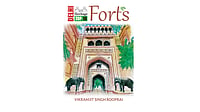The moment Ethel Proudlock comes into the story, one has a vision of Bette Davis shooting a man in the back in a film based on Somerset Maugham’s The Letter. Somerset Maugham is one of the characters in Tan Twan Eng’s new novel The House of Doors which is set in his home terrain of Malaya — in this case Penang, rather than the mysterious slopes and hazy greens of The Garden of Evening Mists, Eng’s Booker shortlisted novel.
Eng tells his story through two narrators — Willie Maugham and his hostess Lesley Hamlyn. They turn about and recount events in colonial Penang seen through the points of view of the colonisers rather than the author’s own Straits Chinese ancestors. It is the cloistered white world of privilege that he depicts in this historical novel, with the Proudlock shooting at its heart. The story is told through confidences revealed to the world’s most famous author who sees himself as an anonymous confessor figure — though Maugham himself has confessions hidden deep within that he never really reveals. In the novel, the bankrupt Maugham is looking to recoup his lost fortunes through a bestseller while keeping the fact close to his chest — it is a bad time for him since he is shaky on health down and out of his luck and worried about losing his boyfriend.
It isn’t an easy time for Lesley either — her husband is planning to move to South Africa and she has lived all her life in the narrow world of Penang with its white community, its nyonyas and the sighing sea. She too has confessions to make, though for her, the truth about Ethel Proudlock is possibly the least of them. Life is about love, getting one’s own back on a cheating husband and opening the doors to freedom.
Sun Yat Sen also plays a role in this novel — in fact Eng rejigged the time frame so that the Proudlock case, which actually took place in 1911, coincided with Sun’s visit to Penang in the 1920s. Whether accuracy is important for historical novels or not is something the reader has to decide. However, Sun Yat Sen introduces the actual house of doors to the novel, a space decorated with the amazing painted doors belonging to the shophouses where Lesley finds her freedom as she steps across the threshold dividing the races changing her clothes and almost changing her skin.
In Lesley’s case, her actions are more revenge than social activism, though she flaunts her status of open minded ‘angmoh’ — so much so that Maugham and her husband suspect her of having an affair with the handsome Sun Yat Sen. Sun sadly does not come to life in Eng’s pages and nor does his cause. Maugham is more vivid — though again, it is Eng’s perception of the writer that he conveys and for a writer to describe another as seen through the latter’s words can prove to be quite a balancing act, though Maugham’s fictional words seem to have the right amount of reality to them: “A man is more willing to open up to you once you’ve revealed something personal, something shameful about yourself.
However, Maugham gets away by dishing the dirt on the Penang white community while revealing none of his own secrets and he recovers much of his lost fortune. The implication is that he is protected by the mysterious hamsa, a Moroccan symbol which appears in all his books and which runs like a leitmotif through the novel.
Eng has embarked on an ambitious project choosing to deal with real people with the short stories in Maugham’s Casuarina Tree as his source material. At one level the book deals with the life of the artist, looking for inspiration desperate to live up to the last success. At another it deals with patriarchy and possession. Occasionally, despite Eng’s mastery of pace and character, the narrative is held up by incidents which are poetic but add nothing to the context.
Though she doesn’t approve of Maugham’s lifestyle, Lesley comes to see him as a man forced by circumstance to wear a mask — something that she herself has had to do through parallel circumstances. And there is Ethel Proudlock’s mask which she wears through the court case that forms the core of the book. Though The House of Doors is about love and betrayal, it is a many layered thing — everything is not as it seems. Eng focuses on the exteriority of his characters as they tell their varied stories using language that matches the time he writes about with a self conscious formality of simile — worthy of Maugham’s own self consciousness.
In the end, the story within a story within a story comes full circle.
(Views expressed are personal.)


























